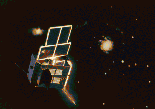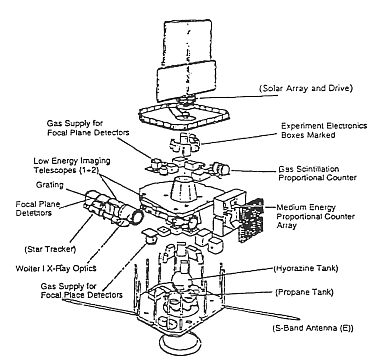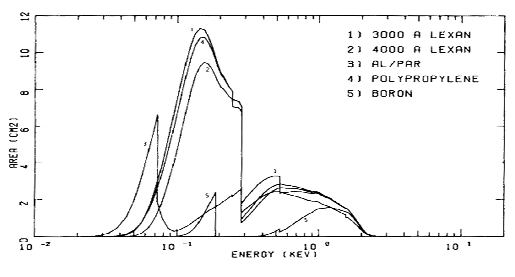|
|
The EXOSAT Observatory

The EXOSAT satellite was a European Space Agency (ESA) mission launched on 1983
May 26 from the Vandenberg complex in the USA on a Thor-Delta rocket and put in
a highly eccentric orbit (e~ 0.93) with a 90.6 hr period and an inclination of
73 degrees. The mission lifetime was ultimately limited by orbital decay, which
was projected to occur within 3 yr. The spacecraft performed within
specifications for almost three years. On 1986 April 9 a failure in the
attitude control system caused the loss of the spacecraft. The natural decay of
the orbit caused EXOSAT to re-enter on 1986 May 6th.
The three instruments on board the EXOSAT observatory, (LE, ME, GSPC) were
complementary and designed to give complete coverage over a wide energy band
pass of 0.05-50 keV.
The figure shows an exploded view of the EXOSAT satellite showing the
scientific instruments and the principal spacecraft subsystems.
 The low energy imaging telescopes (0.05-2.5 keV) gave both
medium quality spectral resolution using the gratings, or broad band filter
spectroscopy. The field of view was about 2 degrees, with a peak effective area
of 10 cm2 ( reduced by a factor of ten when the gratings were utilized). The ME
detector gave spectra with 20% resolution at 6 keV, with a total effective area
of 1600 cm2. Each half of the ME detector array could be offset to monitor
the particle background. A gas scintillation proportional counter (GSPC)
provided a factor of 2 improved spectral resolution in the 2-30 keV band, but
with a factor of 10-20 less effective area than the ME. The optical axes of the
four telescopes (LE1, LE2, ME and GSPC) were coaligned.
The low energy imaging telescopes (0.05-2.5 keV) gave both
medium quality spectral resolution using the gratings, or broad band filter
spectroscopy. The field of view was about 2 degrees, with a peak effective area
of 10 cm2 ( reduced by a factor of ten when the gratings were utilized). The ME
detector gave spectra with 20% resolution at 6 keV, with a total effective area
of 1600 cm2. Each half of the ME detector array could be offset to monitor
the particle background. A gas scintillation proportional counter (GSPC)
provided a factor of 2 improved spectral resolution in the 2-30 keV band, but
with a factor of 10-20 less effective area than the ME. The optical axes of the
four telescopes (LE1, LE2, ME and GSPC) were coaligned.
The telemetry rate was 8 kbps. An on board computer (OBC), programmable from the ground, preprocessed and
compressed the data. The flexibility given by the OBC and the capability to
load on board new OBC programs, enhanced the quality of the science obtained,
by writing new data modes to address science discoveries not foreseen before
launch. It also proved invaluable to work around problems with the
instrumentation and the spacecraft.
The orbit of EXOSAT was quite different from that of any previous X-ray
astronomy satellite. The initial apogee was 191,000 km and the perigee 350 km.
The science instruments were operated above 50,000 km, outside the earth's
radiation belts. This allowed scientific operations for up to 76 hr per 90 hr
orbit, without interruption. EXOSAT was visible from the ground station at
Villafranca in Spain for almost the entire time that the science instruments
were operated and there was no need for any onboard data storage. The attitude
was controlled, to within 1 arc second, using one of two star trackers (each
attached to a low energy telescope), three gyros and a sun sensor.
The first 8 weeks after launch were dedicated to a performance verification
phase. After this the regular guest observer program was undertaken. By the end
of the operational phase four announcements of opportunity had been made with
98 %, 94 %, 64 % and 18 % of each program completed. During these 3 years
scientists around the world used EXOSAT to study most classes of X-ray sources
and made many new discoveries. Perhaps the most notable were the discovery of
quasi-periodic oscillations (QPO) from low mass X-ray binaries, soft excesses
from AGN, the red and blue shifted iron K line from SS433, many orbital periods
from low mass X-ray binaries, and several new transient sources. The public
availability of these data contributed to many notable systematic studies of
individual classes and the archive continues to be heavily used and is still
yielding new results.
The two LE telescopes and detectors assemblies were identical. The telescopes
consisted of double nested gold coated Wolter type I grazing incidence optics,
with a focal length of 1.1 meter and an outer diameter of 0.3 meters. The
telescope parameters give a high energy cut-off of ~2 keV.
The on-axis half
energy width of the point spread function is 24 arc seconds, which degrades to
4 arc minutes 1 degree off-axis. Vignetting in the telescopes reduces the
off-axis effective area to 45 % of its peak value 1 degree off-axis. In the
focal plane of each telescope either a CMA, or a PSD detector was interchanged.
Also a transmission grating spectrometer (TGS) could be inserted behind each
telescope and the dispersed spectrum imaged by each CMA. The gratings were 500
lines mm-1 in one telescope (LE2+CMA2 8-400Å) and 1000 line mm-1
in the other (LE1+CMA1 8-200Å) with a spectral resolution of 2Å
and 1Å respectively for energies > 0.25 keV, and 5Å at
304Å in both telescopes.
The CMA detector has no intrinsic energy resolution in the X-ray band, but a
number of different filters gave coarse spectral information (analogous to UBV
photometry). The choice of filter dictates the energy response with the overall
energy window covered by the filter combinations ranging from 0.05 to 2.0 keV.
The detection efficiency of the CMA 's decreases of 30% at 0.15 keV to 7 %
at 1.5 keV. The combined telescope and CMA on-axis effective area is shown in
figure as function energy for each filter.
 The CMA's are sensitive to ultraviolet photons and this caused contamination by
bright O and B stars, pointed or serendipitous, in the field. Filters were used
to determine the degree of contamination. The boron filter was free of UV
contamination and relatively safe, as was the Al/P, except for very brightest
and earliest stars. Also, the sum signal distribution of events in the CMA
provided a crude method of differentiating between X-ray and UV sources. The
most commonly used filters during the mission were 3000 Lexan , Al/P and boron.
The CMA's are sensitive to ultraviolet photons and this caused contamination by
bright O and B stars, pointed or serendipitous, in the field. Filters were used
to determine the degree of contamination. The boron filter was free of UV
contamination and relatively safe, as was the Al/P, except for very brightest
and earliest stars. Also, the sum signal distribution of events in the CMA
provided a crude method of differentiating between X-ray and UV sources. The
most commonly used filters during the mission were 3000 Lexan , Al/P and boron.
The CMA particle background counting rate was typically 8 X 10-6
count/s/pixels2 (a pixel is 4 arcsec) in the central region. The background
counting rate depends on the strength of the solar wind. In 90% of the
observations the average background counting rate is within a factor of 2 of
the quiescent value. The average source detection threshold for a 104 second
exposure (a typical minimum observation time) within the central 12 arc minute
radius region of the detector, using the 3000 Lexan filter, was 2 X 10-3
count/s. For observations longer than a few thousand seconds the sensitivity of
the CMA is background limited. Source positions can be estimated to 6 arc
seconds and 8 arcsec error radius at 67 % and 90% confidence levels,
respectively within the central 12 arc min.
There were a number of notable
problems with the instrumentation associated with the LE's. Both PSD's failed
early on during the performance verification phase. One of the CMA (CMA2)
failed on 1983 October 28. The mechanism to insert the grating behind the other
telescope (LE1) failed in 1983 September 15, eliminating this spectroscopic
capability. The surviving CMA functioned well until the end of the mission.
The Medium Energy (ME) instrument consisted of an array of eight proportional
counter, with a total geometric area of 1600 cm2 and 45 arcmin FWHM field
of view, providing spectral and temporal data in the 1-50 keV energy range.
Each proportional counter had two gas
chambers separated by a 1.5 mm beryllium window with argon in the top layer and
xenon in the lower. Each proportional counter used a multi-wire design with a
deltaE/E of 21(E/6 keV)-0.5 % FWHM for the argon chambers and
18(E/22 keV)-0.5 % FWHM for the xenon chambers. The argon and xenon spectra were
pulse height analysed into 128 channels each, sensitive to 1-20 keV and 5-50 keV
energy range respectively.
The ME background was very stable and dominated by
particle events from the solar wind and radioactive lines caused by the decay
of residual plutonium in the Beryllium windows and detector bodies. The
background count rate per detector were in the argon chamber 2.4, 4.3 and 9.4
count/s in the energy range 1-6, 1-10 and 1-20 keV, respectively, and 40.6 and
59.1 count/s in the xenon chamber in the 10-30 and 10-50 keV energy range,
respectively. Occasional background flares occur in both the aligned and offset
halves caused by enhancements in the solar wind. A major solar storm typically
happened every six months, causing the background to increase by several order
of magnitude. The detectors were turned off during these events.
To
optimize the background subtraction each half of the ME array detector could be
offset from the source, pointing a source-free region of the sky to monitor the
particle background. The offset half was alternated every few hours (known as
'array swap'). Since the background obtained from the offset half was slightly
different for the half of the detector on source, Difference spectra were
created to correct this effect. Background was also obtained using the slew on
and/or off the source. This technique was used when the detector halves were
coaligned and no array swaps made during the observation.
In 1985 August 20 one
of the detectors in half-1 failed. Occasionally because of small detector
breakdown and/or reduction in the gain, observations were carried out with one
or more detectors off for a few hours.
An important component in the operation of the ME instrument was the usage of
the OBC. Depending on the
objective of the observation, the OBC programs traded time resolution against
spectral information and telemetry load. Two or three ME programs were
typically run simultaneously. The table gives an overview of most commonly
used ME OBC mode.
| Program |
Output |
Time
resolution |
No of PHA
Channels |
Comment |
| HER4 |
Spectral
Intensity |
10, 5, or 2.5s
150, 125 or 31ms |
128+128 |
det, quad, or half
summed over Ar+Xe |
| HER5 |
Spectral
Intensity |
1s
0.31s |
selectable |
only half
summed over Ar |
| PULS |
Spectral |
fold over period |
selectable |
for fast pulsars |
| HTR3 |
Intensity |
4,8 or 16ms |
Ar and/or Xe |
low OBC usage |
| HTR4 |
Intensity |
0.25ms |
1 |
selectable channel |
| HER6 |
Intensity |
typically 4ms |
1 or 2 |
selectable channel |
| HER7 |
Intensity |
typically 4ms |
1, 2 or 4 |
selectable channel |
A typical ME observation was carried out with a
primary spectral oriented program and a secondary high time resolution
program. The OBC introduced a count rate dependent deadtime due to the limited
data sampling.
The gas scintillation proportional counter, GSPC, (Peacock et al (1981) on
EXOSAT has a deltaE/E of 4.5(E/6 keV)-0.5 % FWHM, (a factor of 2
better than the ME experiment) with a peak effective area of ~100 cm2.
The energy spectra were pulse height analysed into 256 channels.
Three
different electronic gain modes were used: gain 1 = 2-32 keV, gain 2 = 2-16 keV
and gain 0.5 = 2-64 keV. The latter was only used on the very bright source Sco
X-1. Variations in the intrinsic detector gain caused by temperature variations
were removed using two background line features at 10.54 and 12.70 keV caused
by fluorescence in the lead collimator and the radioactive decay of residual
plutonium in the beryllium window. In addition a Xenon L feature at 4.78 keV
could also be used for bright sources to calibrate the gain.
The particle background rejection used burst length discrimination, which rejects
events which have exceptionally long or short duration. The background shape
spectrum remains constant during the short timescale variations, but shows
small changes on longer timescales. The standard OBC mode used in the GSPC
gives 256 channel spectra every 8 seconds. Higher time resolution was used only
for bright sources and if the telemetry needs of the other experiments was low.
The GSPC worked perfectly for the entire mission.
[EXOSAT Home]
[About EXOSAT]
[Archive]
[Software]
[Gallery]
[Publications]
Page authors: Lorella Angelini Jesse Allen
HEASARC Home |
Observatories |
Archive |
Calibration |
Software |
Tools |
Students/Teachers/Public
Last modified: Wednesday, 08-Oct-2003 18:36:10 EDT
|

 The Gas Scintillation Proportional Counter
The Gas Scintillation Proportional Counter 

 The low energy imaging telescopes (0.05-2.5 keV) gave both
medium quality spectral resolution using the gratings, or broad band filter
spectroscopy. The field of view was about 2 degrees, with a peak effective area
of 10 cm2 ( reduced by a factor of ten when the gratings were utilized). The ME
detector gave spectra with 20% resolution at 6 keV, with a total effective area
of 1600 cm2. Each half of the ME detector array could be offset to monitor
the particle background. A gas scintillation proportional counter (GSPC)
provided a factor of 2 improved spectral resolution in the 2-30 keV band, but
with a factor of 10-20 less effective area than the ME. The optical axes of the
four telescopes (LE1, LE2, ME and GSPC) were coaligned.
The low energy imaging telescopes (0.05-2.5 keV) gave both
medium quality spectral resolution using the gratings, or broad band filter
spectroscopy. The field of view was about 2 degrees, with a peak effective area
of 10 cm2 ( reduced by a factor of ten when the gratings were utilized). The ME
detector gave spectra with 20% resolution at 6 keV, with a total effective area
of 1600 cm2. Each half of the ME detector array could be offset to monitor
the particle background. A gas scintillation proportional counter (GSPC)
provided a factor of 2 improved spectral resolution in the 2-30 keV band, but
with a factor of 10-20 less effective area than the ME. The optical axes of the
four telescopes (LE1, LE2, ME and GSPC) were coaligned.
 The CMA's are sensitive to ultraviolet photons and this caused contamination by
bright O and B stars, pointed or serendipitous, in the field. Filters were used
to determine the degree of contamination. The boron filter was free of UV
contamination and relatively safe, as was the Al/P, except for very brightest
and earliest stars. Also, the sum signal distribution of events in the CMA
provided a crude method of differentiating between X-ray and UV sources. The
most commonly used filters during the mission were 3000 Lexan , Al/P and boron.
The CMA's are sensitive to ultraviolet photons and this caused contamination by
bright O and B stars, pointed or serendipitous, in the field. Filters were used
to determine the degree of contamination. The boron filter was free of UV
contamination and relatively safe, as was the Al/P, except for very brightest
and earliest stars. Also, the sum signal distribution of events in the CMA
provided a crude method of differentiating between X-ray and UV sources. The
most commonly used filters during the mission were 3000 Lexan , Al/P and boron.